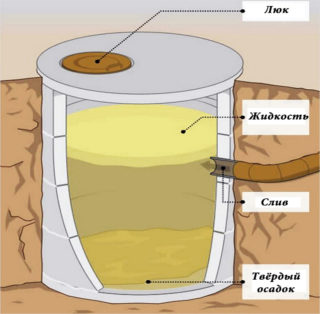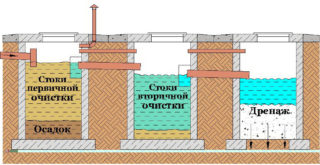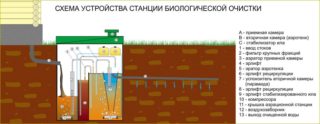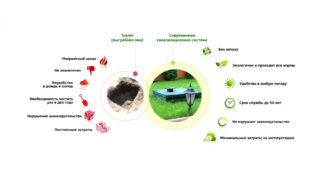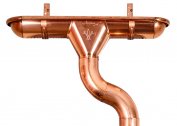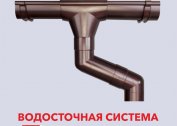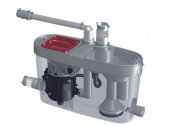In rural areas, there is no possibility of connecting to a centralized sewage system, therefore, for the discharge of polluted effluents in suburban buildings, VOCs are arranged - local treatment systems. Most often, septic tanks are used for these purposes.
Definition and purpose of septic tanks
Cesspools - The most primitive and cheapest waste disposal, but not hygienic. At the bottom of a dug hole, a foundation is made of concrete or brick. The walls of the structure are isolated from leaks, periodically pumping its contents. There is a persistent unpleasant odor that spreads over the site. The distance from the drain pit to the residential building should be 10-12 m according to SNiP.
Septic tanks with soil filtration have become more common. Several sealed containers are buried in the ground. Barrels are mounted in such a way that water flows from one vessel to another. At the bottom of each of them particles of different sizes settle. From the last tank, water through drainage pipes enters the filtration field, which is arranged from gravel and sand. There is a natural purification of water that seeps into the soil.
Filtration fields do not allow the area to turn into a swamp. But they require care. With a frequency of once every 3-5 years, the drainage layers are removed and re-filled. Sealed containers are also clogged with sediment, so they need to be cleaned 1-2 times a year.
AT biological treatment plants aerobic clarification of wastewater occurs. This is a progressive method of waste disposal used in the urban system.
For an individual building or system of cottages, stations with equipment of lower productivity are used. These are containers in the form of rectangular cubes with a side size of 1 m and a depth of 2-3 m. They are buried in the ground. Additionally, several compressors are built in, which bubble the wastewater with air bubbles to better mix with activated sludge so that microbes that eat leftover food and fat deposits can develop.
All wastewater contents are processed into safe sludge. It should be scooped up and used as fertilizer for green spaces. Outlet water is purified up to 98%. You should not drink it, but you can water the garden.
SBOs have certificates from the environmental safety oversight system. Their device is economically viable and affordable for residents of rural areas. Unlike septic tanks, treatment plants require an energy supply system to connect compressors. The power of the station is small, consumption is comparable to a 100 W light bulb, but if the electricity is turned off for 1-2 days, beneficial bacteria living in activated sludge die.
Device and principle of operation
Septic tanks of accumulative type work as a modified cesspool, where all drains from the house and the adjacent area merge. Heavy particles settle to the bottom of the sedimentation tank, lighter suspension and fat inclusions remain on the surface.
Unlike a cesspool, septic tanks have a sealed device. Technique is used to remove deposits. If the quantity of wastewater is small, for example, in a country house, the storage tanks justify their purpose, the simplicity of their arrangement satisfies consumers. It is necessary to monitor the water level in order to pump out in time.
Overflow septic tanks are purchased for cottages in which people constantly live. They also need cleaning, but much less often.They work on the principle of cascading fluid transfusion:
- Chamber No. 1 is designed for settling of heavy waste.
- Drainage from the first tank, poured from large inclusions, overflows into chamber No. 2. This is the workplace of aerobic bacteria, which in the process of their activity decompose organic residues. The degree of purification is 60%.
At the third stage, water purified from organic matter enters the filtration fields, where it is naturally purified through a drainage filling.
Types of septic tanks
- performance
- principle of work;
- reliability of cleaning.
Storage tanks are made of plastic, metal, brick or reinforced concrete. They can be horizontal and vertical, surface or underground. To select VOCs, the volume of wastewater is determined, which depends on the number of people living, the connection of washing and dishwashers, sinks, bathtubs, showers.
Metal barrels under septic tanks rust from time to time, so their choice is an unfortunate option.
For private homes where they live permanently, it is preferable to stay on VOCs with soil filtration or bio-treatment. Reinforced concrete rings, cheap and durable, are used to construct the tank.
Mounting Features
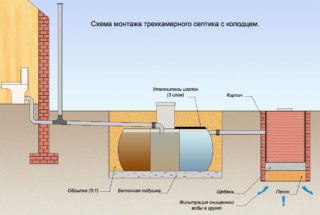 Plastic septic tanks have several advantages: lightweight, resistant to corrosion and ensure the tightness of the device. However, their low weight becomes a disadvantage in the flood, since the sumps float when the groundwater level rises. To eliminate the consequences, a concrete base is mounted under the tank, to which the tanks are attached.
Plastic septic tanks have several advantages: lightweight, resistant to corrosion and ensure the tightness of the device. However, their low weight becomes a disadvantage in the flood, since the sumps float when the groundwater level rises. To eliminate the consequences, a concrete base is mounted under the tank, to which the tanks are attached.
The brick installation is arranged according to the following algorithm:
- soil is removed under the set parameters of the septic tank;
- the foundation is poured;
- brick walls are laid out;
- for waterproofing, wipe the walls from two sides;
- outside, an additional layer of mastic is applied.
The design of the device does not require a call of equipment, building materials are commercially available.
Advantages and disadvantages of septic tanks
Storage tanks have the simplest device, but with an increase in runoff, costs for the services of sewage trucks increase.
Pros of using overflow VOCs:
- simple cleaning method;
- simple maintenance;
- effluents are treated before discharge into the ground or natural reservoir;
- reduction of costs for the call of sewer equipment;
- work even in conditions close to the surface of soil water.
The disadvantage of this device is the impossibility of their use for the purification of water in clay areas, as this will lead to the formation of puddles.
Biological treatment plants can be installed in areas with even heavy soils. They provide high wastewater treatment, making them safe for subsequent use for economic purposes. It takes 2 days to set up a septic tank, but subsequent operation does not require constant monitoring. Sludge is removed once every 5 years.
High cost is the main disadvantage of SBO. Another drawback is the need for power supply, as efficiency drops during power outages.
Septic prices
When choosing a storage septic tank, preference should be given to tanks with a large volume and strong walls that do not deform under soil pressure, as this can lead to leaks.
The price of a plastic tank under a septic tank is 13 thousand rubles.
Septic Tank Unilos, which provides deep biological treatment of effluents up to 98%, made of polypropylene, has a cost of 76 thousand rubles. The material is resistant to sunlight, low temperatures and mechanical stress. The device is adapted to the climatic conditions of Russia. The warranty from the manufacturer is 2 years.
Septic tank Alta Ground Master 22 is intended for a group of cottages.The device has a 60 year life span. There are no restrictions on the discharge of household waste. Does not require power supply. The cost is 529 thousand rubles.
Septic Topop 6 LONG is designed for 6 people, its capacity is 1000 liters per day. Warranty from the manufacturer - 3 years. Tank dimensions 1.2 * 1 * 3.1. Electricity consumption is 1.5 kW daily. The cost of the product is 123 thousand rubles.
